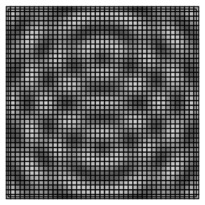En cliquant sur une imagette, vous accéderez au source et à l'image. En cliquant sur cette dernière, vous ouvrirez le fichier PDF associé.














/* -*-ePiX-*- */ #include "epix.h" using namespace ePiX; const double MAX(3); int main() { bounding_box(P(-MAX,-MAX),P(MAX,MAX)); unitlength("1in"); picture(6,6); begin(); camera.at(30,5,20); revolutions(); domain R(P(0,0,-0.25), P(3,1,0.25), mesh(12, 48, 24), mesh(12, 96, 120)); std::list<domain> cuts; double Phi(7.0/48), Theta(7.0/48); cuts.push_back(R.slice1(2)); cuts.push_back(R.slice2(0)); cuts.push_back(R.slice2(Theta)); cuts.push_back(R.slice3(0)); cuts.push_back(R.slice3(Phi)); fill(); surface(sph, cuts); fill(false); arrow_fill(1); arrow(P(3,0,0), P(3.5,0,0)); label(P(3.5,0,0), P(-2,-2), "$x$", bl); arrow(P(0,3,0), P(0,3.5,0)); label(P(0,3.5,0), P(2,-2), "$y$", br); arrow(P(0,0,3), P(0,0,3.5)); label(P(0,0,3.5), P(0,4), "$z$", t); bold(); arc_arrow(P(0,0,0), 2, 0.5*Theta, Theta); arc_arrow(P(0,0,0), 2, 0.5*Theta, 0); aarrow(P(0,0,0), sph(2, Theta, Phi)); label(sph(2, 0.5*Theta, 0), P(2,2), "$\\theta$", t); label(sph(2, Theta, 0.5*Phi), P(-2,0), "$\\phi$", l); label(sph(1, Theta, Phi), P(2,-2), "$\\rho$", br); dashed(); plain(); line(P(0,0,0), P(2,0,0)); line(P(0,0,0), sph(2, Theta, 0)); line(P(0,0,0), sph(2, Theta, Phi)); end(); }




